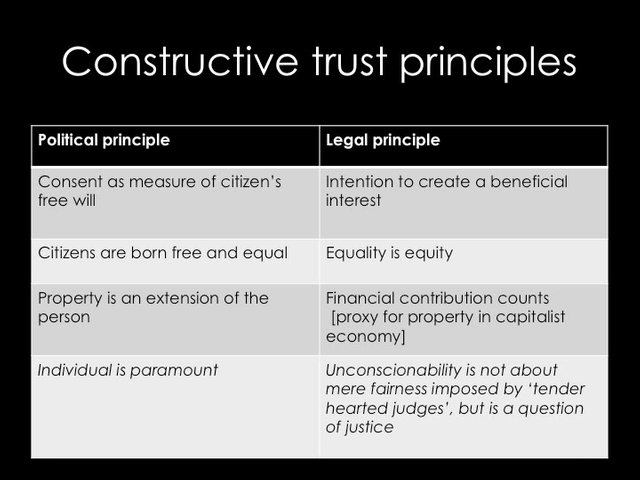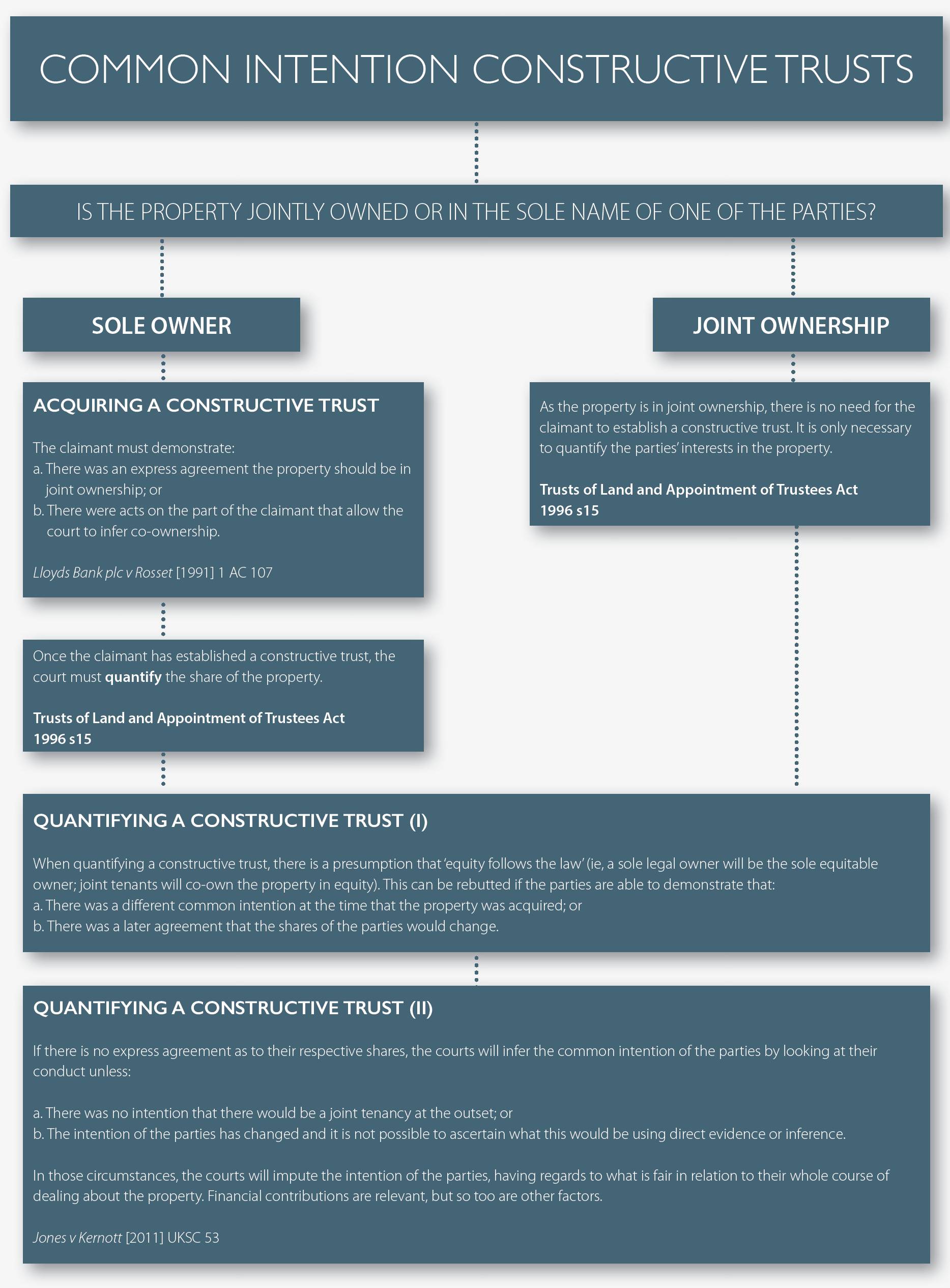Introducing the Benefits of a Useful Count On Managing Beneficiary Conflicts
The concept of a constructive trust emerges as an essential tool in the intricate world of recipient problems, providing a nuanced service to disputes that frequently emerge from wrongful property retention. By cultivating a fiduciary relationship in between parties, this equitable remedy not just promotes quick resolutions however likewise offers to hinder prospective transgression. As we check out the multifaceted advantages of constructive counts on, one may start to question how these devices can improve the landscape of estate disagreements and contribute to a much more equitable distribution of possessions among beneficiaries.
Meaning of Constructive Depend On
A constructive count on is often established by courts to resolve circumstances where one celebration has wrongfully obtained or preserved property that truly belongs to one more (What Is A Constructive Trust). This legal principle is not a traditional count on, as it does not call for the procedures generally connected with count on creation, such as a written arrangement or the intent of the celebrations included. Instead, a useful trust fund occurs by procedure of regulation, offering as an equitable solution to stop unjust enrichment
The courts impose a useful trust when it is determined that event holds building under conditions that, in equity and excellent principles, should not allow them to retain it. Usual circumstances entail deceitful actions, violations of fiduciary task, or situations where a celebration has gotten residential or commercial property with inappropriate means. The constructive trust fund hence functions to secure the rights of the rightful proprietor by making sure that the building is held for their advantage.
As soon as established, the useful depend on requires the event in belongings of the residential property to share it to the rightful owner, thus fixing the wrongful situation. This system highlights the lawful system's commitment to fairness and justice in residential property disagreements, highlighting the relevance of ethical conduct in ownership and transfer of assets.
Benefits of Positive Counts On
Positive counts on offer a number of considerable benefits in legal conflicts including building legal rights. Primarily, they act as an equitable treatment, permitting courts to resolve scenarios where an event has wrongfully acquired or retained property that truly comes from one more. This develops a structure for fairness, making sure that the rightful owner is compensated and the unfair enrichment of the crook is reduced.
In addition, positive counts on can expedite resolution in disputes over estate properties, consequently minimizing the prolonged and commonly contentious lawsuits processes related to traditional property disputes. Their versatility enables courts to tailor treatments to fit the particular conditions of each instance, which can lead to more sufficient end results for all events involved.
Furthermore, useful counts on promote openness and liability among recipients and fiduciaries, as they require the last to act in the most effective passions of the previous. This strengthens the stability of fiduciary partnerships, promoting trust and teamwork. Lastly, by dissuading transgression associated to home possession, useful counts on add to the total stability of monetary and lawful systems, making certain that residential or commercial property legal rights are respected and promoted within culture.
How Positive Counts On Job

In practice, when a useful trust is enforced, the court recognizes the home in concern and establishes a fiduciary relationship between the celebrations entailed. The party who holds the residential or commercial property becomes a trustee, obliged to handle it for the advantage of the rightful proprietor, referred to as the recipient. This partnership is not based upon an official arrangement yet instead on the concept of equity, intending to fix situations where one party's gain directly associates with one more's loss.

Case Research Studies and Examples
When taking a look at the sensible application of constructive trust funds, various case studies highlight exactly how courts navigate complicated situations including unfair enrichment. One remarkable case is * Pettkus v. Becker *, where the High Court of copyright developed a positive depend rectify the unfair enrichment of one party over one more in a lasting relationship. The court established that the payments of one companion to the procurement of home justified the charge of a constructive depend on, making certain fair circulation.
An additional considerable instance is * Gisborne v. Gisborne *, where the court imposed a constructive depend address the insurance claims of brother or sisters over their departed brother's estate. The court identified the contributions made by the brother or sisters in keeping the family members building, resulting in a choice that called for the estate to account for those contributions, thereby avoiding unjustified enrichment.
These instances exemplify just how constructive depends on can properly solve disputes by concentrating on fairness and the avoidance of unjust enrichment. By analyzing the particular contributions and situations of the celebrations entailed, courts can apply constructive depend achieve simply end results, useful link eventually strengthening the equitable principles underpinning these lawful devices.

Actions to Develop a Constructive Trust
To establish a positive trust, several key actions have to be followed to make sure that the insurance claim is confirmed and legally recognized. First, the plaintiff has to show the existence of a fiduciary relationship or a scenario that necessitates the charge of a constructive count on, such as fraud, unfair enrichment, or a violation of obligation.
Second, it is vital to collect and existing compelling evidence that supports the claim. This consists of documents and statements that illustrate the circumstances causing the claimed wrongful retention of residential property or benefits by the trustee.
Third, the complaintant should submit a request in the suitable court, articulating the premises for requesting the imposition of a positive trust. This request should detail the specifics of the partnership and the unjustified enrichment that necessitates the trust fund.
Final Thought
To conclude, constructive trust funds represent a crucial equitable solution in the realm of beneficiary disputes, effectively addressing wrongful building retention and stopping unfair enrichment. By creating a fiduciary connection, these trust funds improve openness and accountability amongst property holders. The expedited resolution of here are the findings estate disputes and the frustration of misbehavior add to higher stability within legal and economic systems. Eventually, positive counts on advertise justness among beneficiaries, ensuring that rightful ownership is kept and shielded.
A positive trust fund is often developed by courts to attend to scenarios where one party has wrongfully obtained or preserved property that truly belongs to another.The courts impose a positive count on when it is established that one party holds building under situations that, in equity and good principles, should not allow them to keep it. By inhibiting misbehavior related to residential or commercial property ownership, positive counts on add to the total stability of lawful and economic systems, making certain that residential property legal rights are respected and supported within society.
In technique, when a positive count on is imposed, the court recognizes the building in inquiry and develops a fiduciary connection between the parties included. What Is A Constructive Trust. The court established that the contributions of one companion to the purchase of building warranted the charge of a constructive trust, making sure equitable circulation